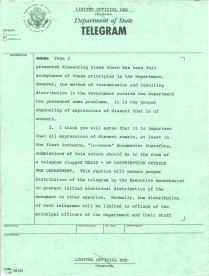Today’s post is written by David Langbart, an Archivist in the Textual Records Division at the National Archives at College Park.
In recent weeks we have seen and heard many media reports mentioning the DISSENT CHANNEL of the Department of State. Most stories note that it finds its origins in the controversies over U.S. policy in Vietnam during the 1960s and 1970s, but provide little other explanation.
While the issue of policy in Vietnam played a part in establishing the Dissent Channel, this special procedure for providing policy-makers with alternative views and recommendations outside the normal channels for the discussion of policies was a direct outgrowth of the management reform activities carried out in the Department in 1970 culminating in the report Diplomacy for the 70’s: A Program of Management Reform for the Department of State. Among other things, those reforms were aimed at creating an atmosphere of openness and stimulating creativity. Not all of the reports recommendations were carried out, but establishment of the Dissent Channel was one significant result.[1]
The following are the foundational documents of the Dissent Channel.
The first announcement of the Dissent Channel came in the following telegram of November 4, 1971, sent by the Department of State to all U.S. diplomatic and consular posts.[2]
To clarify procedures for submitting dissent messages and to explain how those messages would be handled, the Department sent the following airgram to all U.S. diplomatic and consular posts.[3]
In a memorandum of December 15, 1971, Secretary of State William P. Rogers designated the Policy and Coordination Staff as the action office for the Dissent Channel. Today, that office’s successor, the Policy Planning Staff, continues to serve as the action office.[4]
Sources
[1] Documentation on Department of State management reform is in Foreign Relations of the United States, 1969-1976, Volume II: Organization and Management of U.S, Foreign Policy, 1969-1972. See documents 312, 321-326, 329, 332, 338, 339, and 346.
[2] Department of State to All Diplomatic and Consular Posts, Telegram 201473, November 4, 1971, file CR 4, 1970-73 Subject-Numeric File, RG 59: General Records of the Department of State.
[3] Department of State to All Diplomatic and Consular Posts, A-3559, April 8, 1972, file PER 15-8, 1970-73 Subject-Numeric File, RG 59: General Records of the Department of State.
[4] Secretary of State William P. Rogers to William Cargo, Director, Policy and Coordination Staff, memorandum, December 15, 1971, file PER 15-8, 1970-73 Subject-Numeric File, RG 59: General Records of the Department of State.















